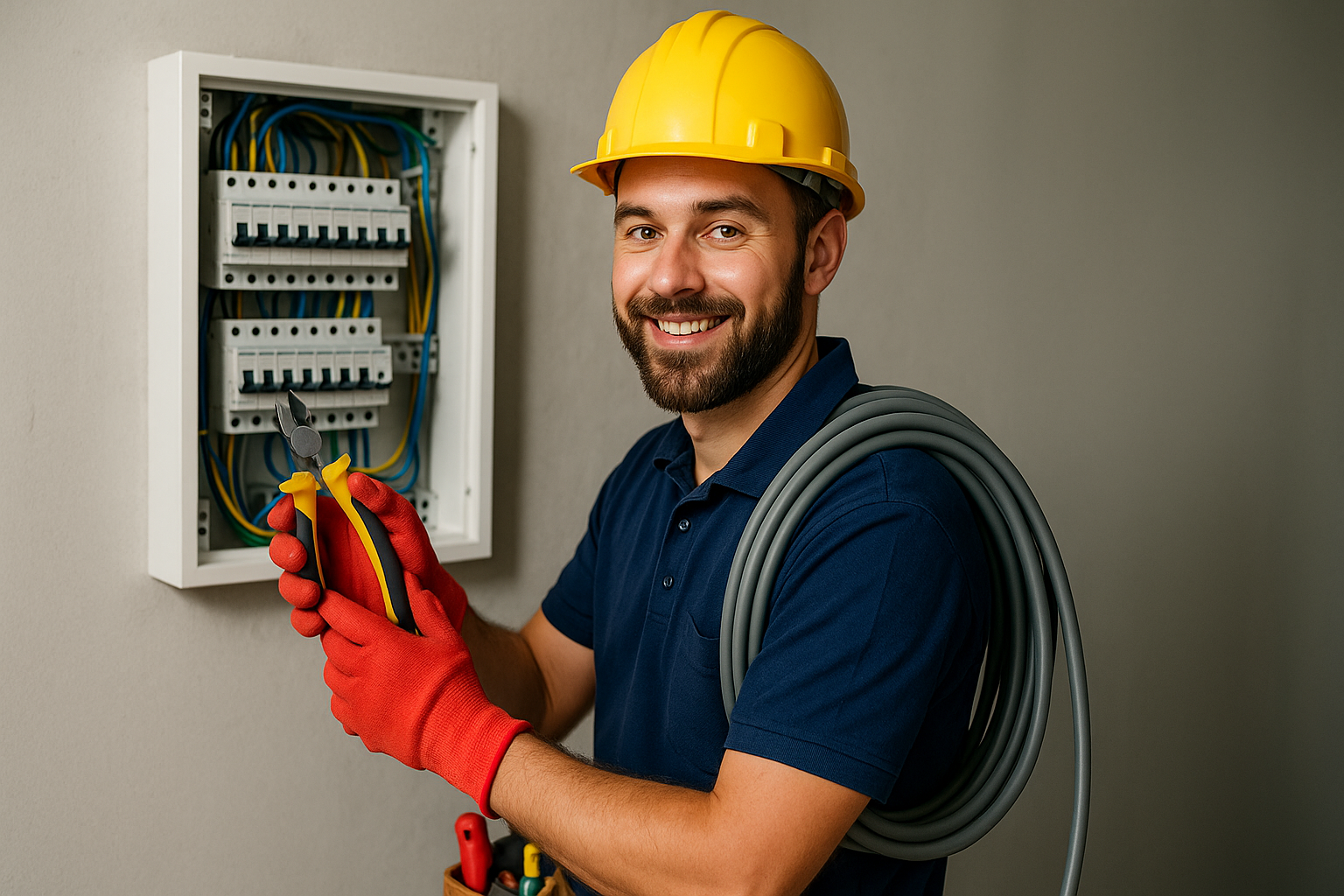Electricity keeps your home running from powering your lights and appliances to charging your devices and keeping you comfortable every day. But while it’s essential, electricity can also be dangerous if not handled properly. Faulty wiring, damaged outlets, or neglected electrical systems can cause serious accidents, including shocks, fires, or appliance damage.
That’s why having an electrical safety checklist is so important. A well-thought-out checklist helps you inspect your home regularly, identify potential hazards early, and ensure your electrical system stays in good working condition.
Here’s a step-by-step guide on how to create an electrical safety checklist for your home, along with what to look for during your inspections.
Start With Your Electrical Panel
Your electrical panel (also known as a breaker box) is the heart of your home’s power system. It distributes electricity to every room and protects circuits from overload.
What to check:
-
Make sure the panel cover is securely in place and free of rust or corrosion.
-
Labels should clearly identify which breaker controls each area or appliance.
-
Breakers should not feel loose or make crackling sounds.
-
If a breaker trips frequently, don’t just reset it — have an electrician inspect the cause.
-
Keep the area around the panel clean, dry, and free from clutter.
Tip: Test your breakers occasionally to ensure they’re functioning correctly. A professional inspection once every few years is also a smart idea.
Inspect Outlets and Switches
Outlets and switches are among the most used (and most ignored) electrical components in your home. Over time, they can loosen, overheat, or wear out.
Your checklist should include:
-
Outlets should be cool to the touch – never warm or hot.
-
No burn marks, discoloration, or buzzing sounds.
-
Tight-fitting plugs (loose plugs can cause sparks or arcing).
-
Cover plates should be intact – no cracks or exposed wiring.
-
GFCI (Ground Fault Circuit Interrupter) outlets in kitchens, bathrooms, and outdoors should be tested monthly.
To test GFCIs: Press the “Test” button – the outlet should turn off. Then press “Reset” to restore power. If it doesn’t respond, it needs replacement.
Check Electrical Cords and Extension Cables
Damaged cords and extension cables are a major cause of electrical fires. They’re often hidden behind furniture or under rugs, where damage can go unnoticed.
Safety checklist for cords:
-
No fraying, cracking, or exposed wires.
-
Cords should not be pinched, twisted, or run under carpets.
-
Avoid daisy-chaining extension cords (plugging one into another).
-
Use cords rated for the correct wattage of the appliance.
-
Unplug extension cords when not in use – they’re for temporary solutions only.
If you find damaged cords, replace them immediately. Never attempt to tape or patch them.
Examine Light Fixtures and Bulbs
Light fixtures may seem harmless, but using the wrong type or wattage of bulb can cause overheating and potential fires.
Include these steps in your checklist:
-
Match the bulb wattage to the fixture’s maximum rating (check the label inside the fixture).
-
Replace flickering or buzzing bulbs – they can signal loose wiring.
-
Ensure fixtures are firmly attached and not wobbly.
-
Keep lamps and shades away from curtains or flammable materials.
-
Use LED bulbs when possible – they’re energy-efficient and produce less heat.
A regular inspection of your lighting fixtures keeps your home brighter and safer.
Review Appliances and Equipment
Appliances are among the most power-hungry items in your home, and faulty ones can be dangerous. Regularly checking them helps prevent shocks, overheating, or electrical fires.
Appliance safety checklist:
-
Power cords are in good condition and firmly connected.
-
No sparks or burning smells during operation.
-
Avoid plugging multiple high-wattage appliances into one outlet.
-
Unplug appliances like toasters, irons, and hair dryers when not in use.
-
Clean dust buildup around large appliances (like refrigerators and dryers) to prevent overheating.
For older or malfunctioning appliances, consider upgrading to newer, energy-efficient models that meet modern safety standards.
Test Smoke Alarms and Carbon Monoxide Detectors
While not electrical devices themselves, smoke alarms and carbon monoxide (CO) detectors play a crucial role in detecting dangers caused by electrical issues or fires.
What to include in your checklist:
-
Test all smoke and CO alarms monthly.
-
Replace batteries at least once or twice a year.
-
Replace the entire unit every 7–10 years, depending on the manufacturer’s instructions.
-
Ensure alarms are installed in every bedroom, hallway, and main living area.
Properly working alarms can save lives by alerting you early to electrical fires or appliance malfunctions.
Evaluate Power Strips and Surge Protectors
Power strips are convenient but often misused. Overloading them can lead to overheating and fire hazards.
Safety reminders:
-
Use surge protectors (not basic power strips) for sensitive electronics.
-
Don’t overload them with too many high-wattage devices.
-
Keep cords untangled and free from dust buildup.
-
Look for UL or ETL certification marks – these meet recognized safety standards.
-
Replace them every few years or after a major power surge.
Avoid connecting one power strip to another – this practice, called “daisy chaining,” is a major fire risk.
Inspect Outdoor Electrical Systems
Outdoor outlets, lights, and tools are exposed to moisture and weather, making them particularly vulnerable.
Outdoor safety checklist:
-
Use weatherproof covers for all outdoor outlets.
-
Ensure outdoor outlets are GFCI-protected to prevent shocks.
-
Check that cords and plugs for outdoor equipment are rated for exterior use.
-
Keep outdoor lights, cables, and decorations away from water sources.
-
Store power tools in a dry, covered area when not in use.
Moisture and electricity don’t mix, so regular inspections of outdoor systems are critical — especially after storms or rainy seasons.
Check for Signs of Electrical Problems
Your senses can often detect early signs of electrical trouble before it becomes dangerous.
Be alert for:
-
Flickering or dimming lights
-
Unusual burning or melting odors
-
Buzzing or crackling sounds from outlets
-
Frequent breaker trips or blown fuses
-
Warm outlets or switches
These warning signs should never be ignored. Contact a licensed electrician immediately if you notice any of them.
Schedule Professional Inspections
While homeowners can perform basic visual checks, only a licensed electrician can conduct a comprehensive safety inspection. They use specialized tools to test circuits, wiring integrity, grounding, and voltage stability.
Professional inspections should include:
-
Testing for proper grounding and bonding
-
Verifying circuit load capacity
-
Checking hidden or hard-to-access wiring
-
Reviewing compliance with local electrical codes
Experts recommend professional inspections every 3–5 years or sooner if your home is old or recently renovated.
Tips for Everyday Electrical Safety
Along with your checklist, here are quick reminders to maintain daily safety:
-
Unplug unused devices to save energy and reduce fire risk.
-
Keep liquids away from outlets, plugs, and electronics.
-
Educate children about the dangers of electricity.
-
Avoid DIY repairs on electrical systems – always hire a qualified electrician.
-
Install AFCIs (Arc Fault Circuit Interrupters) for added protection against arc-related fires.
Keeping safety in mind every day is the best long-term prevention strategy.
Make Electrical Safety a Habit
Creating and using an electrical safety checklist isn’t just about preventing accidents – it’s about ensuring peace of mind. By regularly inspecting your home’s electrical system, you can catch small issues before they become major hazards.
Electricity powers your home, but safety powers your confidence. Take a few minutes each month to walk through your checklist, make small fixes, and schedule professional help when needed. The effort you invest today can protect your home, your loved ones, and your property for years to come.

